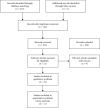Incidence and Predictors of Structural Valve Deterioration after Transcatheter Aortic Valve Replacement: A Systematic Review and Meta-Analysis
- PMID: 33214775
- PMCID: PMC7657687
- DOI: 10.1155/2020/4075792
Incidence and Predictors of Structural Valve Deterioration after Transcatheter Aortic Valve Replacement: A Systematic Review and Meta-Analysis
Abstract
Background: Transcatheter aortic valve replacement (TAVR), widely used as an alternative therapy in patients with severe aortic stenosis, is expected to be offered to low-risk patents with a longer life expectancy. The durability of transcatheter aortic valve is becoming of increasing importance.
Method: PubMed, Embase, and Cochrane CENTRAL from the inception to March 2020 were systematically screened for studies reporting on structural valve deterioration (SVD) in TAVR patients. Incidence of SVD was diagnosed according to the latest European consensus as the primary end point. Predictors of SVD evaluated at multivariable analysis and cumulative incidence function (CIF) of SVD were the secondary end point.
Result: Twelve studies encompassing 10031 patients evaluating the incidence of SVD were included, with a follow-up between 1 and 8 years. The pooled incidence of SVD was 4.93% (95% CI, 2.75%-7.70%, I 2 = 96%) at 1 year and 8.97% (95% CI, 6.89%-11.29%, I 2 = 86%) in the long term (≥5 years). Subgroup analysis was performed to identify the valve type that may result in partial heterogeneity. SVD was more frequent in patents with a valve diameter of <26 mm (HR: 3.57, 1.47-8.69), oral anticoagulants (OAC), exposure at discharge (OR: 0.48, 0.38-0.61), or by a disease of renal dysfunction (OR 1.42, 1.03-1.96).
Conclusion: SVD represents infrequent events after TAVR in the long term (>5 years), occurring more commonly in renal dysfunction patients, with small valve diameter and without OAC exposure. There may be an underestimation of the incidence if we assume death as a competing risk.
Copyright © 2020 Yu-Xiang Long and Zeng-Zhang Liu.
Conflict of interest statement
The authors declare that there are no conflicts of interest to declare.
Figures






Similar articles
-
[Structural valve deterioration after transcatheter aortic valve replacement: a research update].Zhejiang Da Xue Xue Bao Yi Xue Ban. 2025 Mar 25;54(2):183-190. doi: 10.3724/zdxbyxb-2024-0470. Zhejiang Da Xue Xue Bao Yi Xue Ban. 2025. PMID: 40304105 Free PMC article. Review. Chinese.
-
Long-Term Durability of Transcatheter Aortic Valve Prostheses.J Am Coll Cardiol. 2019 Feb 12;73(5):537-545. doi: 10.1016/j.jacc.2018.10.078. J Am Coll Cardiol. 2019. PMID: 30732706
-
Assessment of Long-Term Structural Deterioration of Transcatheter Aortic Bioprosthetic Valves Using the New European Definition.Circ Cardiovasc Interv. 2019 Apr;12(4):e007597. doi: 10.1161/CIRCINTERVENTIONS.118.007597. Circ Cardiovasc Interv. 2019. PMID: 30998397
-
Midterm Durability and Structural Valve Degeneration of Transcatheter Aortic Valve Replacement in a Federal Facility.Innovations (Phila). 2022 Sep;17(5):382-391. doi: 10.1177/15569845221123259. Epub 2022 Oct 11. Innovations (Phila). 2022. PMID: 36217736 Free PMC article.
-
A systematic review on durability and structural valve deterioration in TAVR and surgical AVR.Acta Cardiol. 2021 Nov;76(9):921-932. doi: 10.1080/00015385.2020.1858250. Epub 2020 Dec 11. Acta Cardiol. 2021. PMID: 33302806
Cited by
-
Transcatheter aortic valve replacement: Past, present, and future.Clin Cardiol. 2024 Jan;47(1):e24209. doi: 10.1002/clc.24209. Clin Cardiol. 2024. PMID: 38269636 Free PMC article. Review.
-
Early structural valve deterioration of balloon expandable transcatheter aortic valve leaflets due to intrinsic and extrinsic nodular calcifications in a haemodialysis patient: a case report.Eur Heart J Case Rep. 2024 May 24;8(6):ytae265. doi: 10.1093/ehjcr/ytae265. eCollection 2024 Jun. Eur Heart J Case Rep. 2024. PMID: 38845807 Free PMC article.
-
Contemporary Management of the Aortic Valve-Narrative Review of an Evolving Landscape.J Clin Med. 2024 Dec 29;14(1):134. doi: 10.3390/jcm14010134. J Clin Med. 2024. PMID: 39797217 Free PMC article. Review.
-
Long-Term Bioprosthetic Valve Durability After Transcatheter Aortic Valve Replacement With Supra-Annular Self-Expanding Versus Intra-Annular Balloon-Expandable Valves in Patients With a Small Aortic Annulus.Catheter Cardiovasc Interv. 2025 Apr;105(5):990-997. doi: 10.1002/ccd.31415. Epub 2025 Jan 20. Catheter Cardiovasc Interv. 2025. PMID: 39831761 Free PMC article.
-
[Structural valve deterioration after transcatheter aortic valve replacement: a research update].Zhejiang Da Xue Xue Bao Yi Xue Ban. 2025 Mar 25;54(2):183-190. doi: 10.3724/zdxbyxb-2024-0470. Zhejiang Da Xue Xue Bao Yi Xue Ban. 2025. PMID: 40304105 Free PMC article. Review. Chinese.
References
Publication types
MeSH terms
LinkOut - more resources
Full Text Sources
